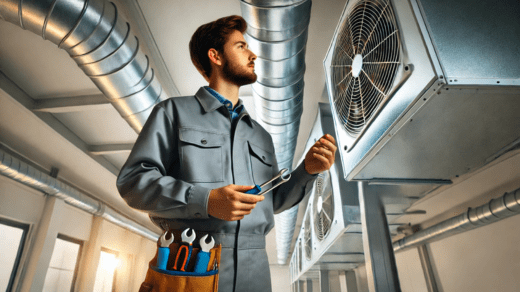Innovations in Eco-Friendly Commercial Ventilation Technology
March 15, 2025

Performance Monitoring and Optimization
Effective performance monitoring and optimization are crucial for ensuring the efficiency and functionality of commercial ventilation systems. By regularly monitoring key performance indicators such as airflow rates, energy consumption, and indoor air quality levels, businesses can identify potential issues early on and implement targeted optimizations to enhance overall system performance. This proactive approach not only helps in reducing operational costs but also extends the lifespan of the ventilation system, ensuring long-term sustainability and reliability.Moreover, leveraging advanced monitoring technologies, such as real-time data analytics and remote diagnostic tools, enables businesses to access valuable insights into the operational efficiency of their ventilation systems. By utilizing this data-driven approach, companies can make informed decisions to optimize system performance, troubleshoot issues promptly, and minimize downtime effectively. Ultimately, the integration of performance monitoring and optimization strategies empowers businesses to achieve optimal ventilation system performance, lower energy consumption, and create a healthier indoor environment for occupants.
Commercial Ventilation systems play a crucial role in maintaining indoor air quality and energy efficiency. By implementing effective performance monitoring and optimization strategies, businesses can enhance system functionality and reduce operational costs. For expert solutions, visit Commercial Ventilation.
– Government Incentives and Rebates
Recent years have seen a surge in government incentives and rebates aimed at promoting eco-friendly practices in commercial ventilation technology. These initiatives serve as a vital catalyst for businesses looking to adopt sustainable solutions and reduce their carbon footprint. By offering financial incentives and rebates, governments incentivize organizations to invest in energy-efficient ventilation systems, ultimately contributing to a greener environment while also reaping cost-saving benefits.For businesses considering a shift towards eco-friendly commercial ventilation technology, taking advantage of government incentives and rebates can significantly offset the initial investment costs. These programs not only make sustainable solutions more financially feasible but also align with the global drive towards environmental conservation. By leveraging these incentives, businesses can make meaningful strides towards enhancing sustainability practices and contributing to a cleaner, more energy-efficient future.
Future Trends in Eco-Friendly Commercial Ventilation Technology
As advancements continue to shape the landscape of eco-friendly commercial ventilation technology, the focus is shifting towards enhancing energy efficiency and sustainability. Incorporating innovative design elements like heat recovery systems and demand-controlled ventilation will be crucial in reducing the carbon footprint of commercial buildings while maintaining optimal indoor air quality.Moreover, the integration of smart sensors and IoT capabilities will play a pivotal role in the future of commercial ventilation systems. By leveraging real-time data and predictive analytics, businesses can proactively monitor and adjust their ventilation settings, ensuring a healthier and more comfortable indoor environment for occupants. Embracing these cutting-edge technologies will not only drive operational efficiencies but also pave the way for a more sustainable and eco-conscious approach to commercial ventilation.
– Advances in Sensor Technology
In the realm of commercial ventilation systems, sensor technology plays a pivotal role in enhancing efficiency and performance. These sensors are intricately designed to monitor various environmental parameters like temperature, humidity, air quality, and occupancy levels within a building. By providing real-time data feedback, sensor technology empowers ventilation systems to adjust and optimize their operations dynamically, ensuring a comfortable and productive indoor environment for occupants.Moreover, advancements in sensor technology have enabled the integration of predictive maintenance features in commercial ventilation systems. By using data analytics and machine learning algorithms, these sensors can anticipate potential issues or malfunctions before they occur, allowing for proactive maintenance and minimizing downtime. This proactive approach not only improves system reliability but also reduces operation costs and extends the lifespan of ventilation equipment, making it a valuable investment for businesses seeking long-term sustainability.
– Integration with Smart Building Systems
In the realm of eco-friendly commercial ventilation technology, the integration with smart building systems stands out as a pivotal advancement. This seamless marriage between ventilation systems and building automation offers a myriad of benefits, such as enhanced energy efficiency, real-time monitoring and control, and predictive maintenance capabilities. By harnessing the power of data and connectivity, businesses can achieve optimized air quality, reduced operational costs, and improved overall comfort for occupants.The integration with smart building systems not only streamlines ventilation operations but also lays the foundation for a more sustainable and intelligent infrastructure. Through automated adjustments based on occupancy levels, weather conditions, and indoor air quality metrics, these systems can adapt in real-time to ensure optimal performance while minimizing environmental impact. As buildings become smarter and more interconnected, the synergy between eco-friendly ventilation solutions and intelligent building management paves the way for a greener and more efficient future.
Natural Home Solutions offer cutting-edge eco-friendly commercial ventilation technology. The seamless integration with smart building systems enhances energy efficiency, real-time monitoring, and predictive maintenance. By optimizing air quality and reducing operational costs, businesses can create a more sustainable and comfortable environment for occupants.
– Use of Artificial Intelligence for Optimization
Artificial Intelligence (AI) is revolutionizing the landscape of eco-friendly commercial ventilation technology. By harnessing the power of AI, ventilation systems can now be optimized in real-time to ensure maximum energy efficiency while maintaining optimal indoor air quality. This sophisticated technology utilizes data analytics and machine learning algorithms to adapt ventilation settings based on various factors such as occupancy levels, outdoor air quality, and temperature fluctuations.Furthermore, AI-driven optimization enables predictive maintenance of ventilation systems, reducing the likelihood of unexpected breakdowns and costly repairs. By analyzing historical data and performance trends, AI can proactively detect potential issues and schedule maintenance activities, ensuring continuous operation and longevity of the system. The implementation of AI for ventilation optimization not only enhances energy efficiency but also promotes a healthier indoor environment, aligning with the increasing focus on occupant well-being and sustainability in commercial buildings.
– Modular and Scalable Designs
Modular and scalable designs have become key considerations in the development of eco-friendly commercial ventilation technology. By offering systems that can be easily expanded or modified to accommodate changing needs, companies like Natural Home Solutions are providing businesses with flexible solutions that can grow alongside their operations. This adaptability not only enhances efficiency but also reduces unnecessary wastage, aligning with the broader sustainability goals of modern enterprises.Incorporating modular and scalable designs into ventilation systems allows for quicker upgrades or adjustments without necessitating a complete overhaul of the existing infrastructure. This agility provides businesses with the opportunity to respond swiftly to evolving requirements, whether due to expansions, renovations, or technological advancements. By embracing this approach, companies can future-proof their ventilation systems, ensuring they remain efficient, cost-effective, and environmentally friendly in the long run.
– Increased Focus on Indoor Air Quality and Health
Effective ventilation and air quality systems are essential for ensuring a healthy indoor environment. Poor ventilation can lead to a build-up of pollutants and contaminants, contributing to health issues such as allergies, respiratory problems, and even more severe conditions. With the increased understanding of the impact of indoor air quality on health, there is a growing focus on implementing advanced ventilation technologies to enhance air circulation and filtration within commercial spaces.As businesses and organizations prioritize the well-being of occupants, the demand for eco-friendly ventilation solutions that promote better indoor air quality continues to rise. From incorporating advanced filtration systems to utilizing smart sensor technology for real-time monitoring, companies are investing in strategies to create healthier work environments. By staying abreast of emerging trends and innovations in eco-friendly ventilation technology, businesses can not only improve the health and productivity of occupants but also demonstrate a commitment to sustainability and environmental responsibility.
In the quest for eco-friendly commercial ventilation technology, the landscape is rapidly evolving. Companies like Natural Home Solutions are at the forefront of this movement, showcasing the marriage of innovation and sustainability. As we look towards the future, it is clear that the integration of advanced sensor technology, artificial intelligence, and smart building systems will be pivotal in optimizing performance and reducing environmental impact.Moreover, the increased focus on indoor air quality and health highlights a shift towards holistic approaches to ventilation systems. By emphasizing modular and scalable designs, businesses can adapt to evolving needs while maximizing efficiency. With government incentives and rebates also playing a crucial role in incentivizing eco-friendly practices, there is a growing momentum towards creating greener and healthier indoor environments.
– Eco-Friendly
In the realm of modern architecture and sustainable building practices, the emphasis on creating eco-conscious spaces has become paramount. Encompassing a wide array of features and technologies, the concept of eco-friendly designs has evolved to include not only energy-efficient systems but also a holistic approach towards reducing the carbon footprint of buildings. This shift towards environmentally responsible construction has led to the rise of innovative solutions that not only benefit the planet but also contribute to healthier and more comfortable living environments for occupants.At the cornerstone of eco-friendly designs lies the integration of natural elements and sustainable technologies that ensure a harmonious balance between the built environment and nature. From incorporating passive design strategies to harnessing renewable energy sources, the focus is on creating spaces that not only minimize resource consumption but also promote the well-being of individuals. By adopting these eco-conscious principles, buildings can not only reduce their environmental impact but also inspire a new wave of design practices that prioritize sustainability and longevity.
